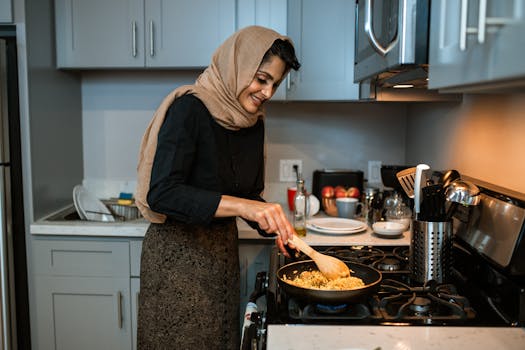News
Thalassery Biryani: A Culinary Delight from the Malabar Coast

-
Table of Contents
- Thalassery Biryani: A Culinary Delight from the Malabar Coast
- The History of Thalassery Biryani
- The Ingredients that Make Thalassery Biryani Special
- The Cooking Technique: Dum Biryani
- The Cultural Significance of Thalassery Biryani
- Q&A
- 1. Is Thalassery Biryani spicy?
- 2. Can Thalassery Biryani be made with vegetables?
- 3. What makes Thalassery Biryani different from other biryanis?
- 4. Can Thalassery Biryani be made without ghee?

When it comes to biryanis, the Thalassery Biryani stands out as a unique and flavorful dish that has captured the hearts and taste buds of food enthusiasts across the globe. Originating from the Malabar region of Kerala, India, this aromatic rice dish is known for its distinct flavors, fragrant spices, and tender meat. In this article, we will delve into the history, ingredients, cooking techniques, and cultural significance of Thalassery Biryani, providing you with a comprehensive understanding of this culinary delight.
The History of Thalassery Biryani
Thalassery Biryani has a rich history that dates back to the 18th century. It is believed to have been introduced by the Arab traders who frequented the Malabar Coast for spice trade. Over time, the local Mappila Muslim community in Thalassery, a coastal town in Kerala, adapted and perfected the recipe, giving birth to the Thalassery Biryani we know today.
The Mappila community, known for their culinary expertise, combined the traditional techniques of making biryani with their own unique flavors and ingredients. The result was a biryani that stood apart from its counterparts in other regions of India. Thalassery Biryani became a staple dish in Mappila weddings and other festive occasions, gaining popularity among locals and eventually spreading its fame beyond the borders of Kerala.
The Ingredients that Make Thalassery Biryani Special
Thalassery Biryani is characterized by its fragrant rice, succulent meat, and a blend of aromatic spices. The key ingredients that contribute to its distinct flavor profile include:
- Khaima/Jeerakasala Rice: The rice used in Thalassery Biryani is a short-grain variety called Khaima or Jeerakasala rice. This rice is known for its unique texture and ability to absorb flavors, making it perfect for biryanis.
- Meat: Traditionally, Thalassery Biryani is made with tender pieces of chicken or mutton. The meat is marinated in a blend of spices and yogurt, ensuring it remains juicy and flavorful.
- Spices: The spice blend used in Thalassery Biryani is what sets it apart. It typically includes cinnamon, cardamom, cloves, fennel seeds, star anise, and bay leaves. These spices infuse the rice and meat with their aromatic flavors.
- Caramelized Onions: Caramelized onions are a crucial component of Thalassery Biryani. They add a hint of sweetness and depth of flavor to the dish.
- Ghee: Ghee, or clarified butter, is used liberally in Thalassery Biryani. It enhances the richness and aroma of the dish, giving it a luscious texture.
The Cooking Technique: Dum Biryani
Thalassery Biryani is cooked using the traditional dum method, which involves slow cooking the rice and meat together in a sealed pot. This technique allows the flavors to meld together, resulting in a biryani that is both aromatic and flavorful.
Here’s a step-by-step guide to cooking Thalassery Biryani:
- Marinate the meat with spices, yogurt, and tenderizing agents like raw papaya or meat tenderizer. Allow it to marinate for at least 2 hours to ensure the flavors penetrate the meat.
- Parboil the rice until it is 70% cooked. Drain the rice and set it aside.
- In a large, heavy-bottomed pot, layer the marinated meat at the bottom.
- Add a layer of partially cooked rice on top of the meat.
- Sprinkle caramelized onions, ghee, and a pinch of saffron-infused milk over the rice.
- Repeat the layers until all the rice and meat are used, ensuring that the top layer is rice.
- Seal the pot with a tight-fitting lid or aluminum foil to trap the steam.
- Cook the biryani on low heat for about 30-40 minutes, allowing the flavors to meld together.
- Once cooked, gently fluff the rice and mix it with the meat before serving.
The Cultural Significance of Thalassery Biryani
Thalassery Biryani holds a special place in the cultural fabric of Kerala. It is not just a dish but a symbol of the region’s rich culinary heritage. The Mappila community, who are predominantly Muslims, consider Thalassery Biryani as an integral part of their cultural identity.
Thalassery Biryani is often served during festive occasions, weddings, and family gatherings. It brings people together, fostering a sense of community and celebration. The aroma of the biryani wafting through the air is enough to evoke nostalgia and create a festive atmosphere.
Moreover, Thalassery Biryani has gained international recognition and has become a must-try dish for food enthusiasts visiting Kerala. Its unique flavors and cooking techniques have made it a favorite among locals and tourists alike.
Q&A
1. Is Thalassery Biryani spicy?
Thalassery Biryani is known for its flavors rather than its spiciness. While it does have a hint of spice, it is not overly hot. The spice levels can be adjusted according to personal preference.
2. Can Thalassery Biryani be made with vegetables?
Yes, Thalassery Biryani can be made with vegetables for those who prefer a vegetarian version. Vegetables like carrots, peas, and potatoes can be added to the biryani to enhance its taste and texture.
3. What makes Thalassery Biryani different from other biryanis?
Thalassery Biryani stands out from other biryanis due to its unique spice blend, the use of Khaima/Jeerakasala rice, and the dum cooking technique. These factors contribute to its distinct flavor profile and make it a culinary delight.
4. Can Thalassery Biryani be made without ghee?
While ghee adds richness and flavor to Thalassery Biryani, it can be substituted with oil for

